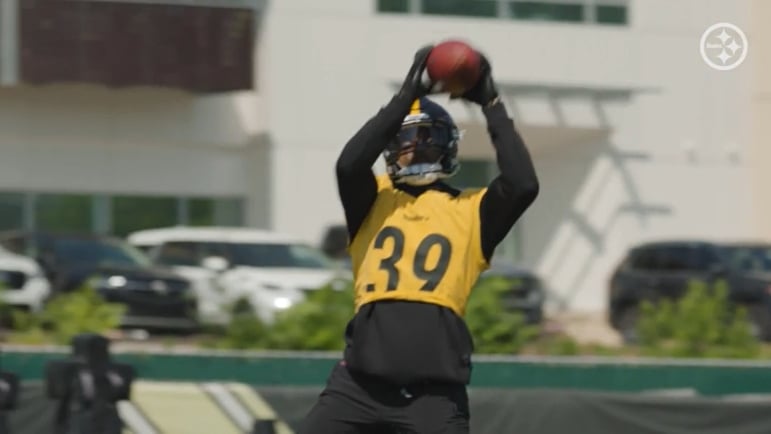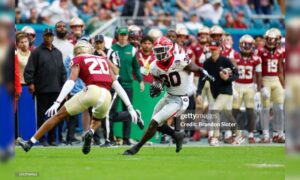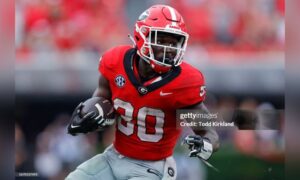Despite fielding a top-level pass rush for the better part of the past decade, the Steelers’ inconsistent play on the back end often prevented them from producing an elite defensive unit. After the front office finally decided to make the much-needed investment into the position, with the additions of Minkah Fitzpatrick, Joe Haden, and Steven Nelson, the Steelers finished top five in points allowed in both 2019 and 2020. The unit similarly finished top five in total yards allowed, top three in passing yards allowed, and atop the league in takeaways in consecutive seasons (first and third, respectively).
Fast forward, and as the team failed to adequately address an aging Haden, along with the absence of a versatile slot player in Mike Hilton. The unit fell in points (22nd), total yards (27th), pass yards (13th), and takeaways (15th). This past season, behind an improved run defense and a greater sense of connectivity in the secondary, Pittsburgh was able to work its way back into the top 10 in scoring defense despite missing 2021 NFL Defensive Player of the Year, and one-man pass-rush unit in T.J. Watt.
Pittsburgh ranked 11th in yards allowed per game, while dropping down to 19th in pass yards allowed per game, and 14th in takeaways. Interestingly enough, despite average total takeaway production, the Steelers finished tied atop the league in interceptions, collecting 20 on the season, 18 of which came from their secondary. Thus, while it is reasonable to anticipate growing pains with some new faces in the secondary, a fully healthy season from Watt could vault Pittsburgh back atop the sack charts and steal some turnover production through that avenue.
Pittsburgh, which began the season 2-6 before finishing 9-8, posted an 8-2 record with a healthy Watt, and found balance on both sides of the ball in the second half of the season. While the Steelers ultimately began to discover an identity and a formula conducive to winning, it is no secret that their 2023 success, and any hopes at ending a half decade long playoff victory-less drought, will come on the shoulders of a dominant defensive performance. In this article, we will be examining the state of the secondary ahead of the 2023 season, looking first individually before examining realistic expectations for the collective group.
Key Departures
A pair of longtime starters in the secondary, the first being Cam Sutton, the team’s top corner last season, and then a glue guy in the unit with his communication skills and coverage IQ who had played alongside All-Pro Minkah Fitzpatrick. While the team will undoubtedly miss Sutton’s pure coverage ability both in the slot and on the boundary, his ability to effectively execute any coverage assignment and cover major ground in Pittsburgh’s inverted coverage schemes will also be far from easy to replace.
The other major departure from the unit was Terrell Edmunds, although admittedly, his skill set is much easier to replace, hence the difference in contact between himself and Sutton. All that being said, Edmunds, for all that he lacked in ball skills, was an extremely reliable box safety, and provided rock solid defense from both an Apex alignment (split EMOL and closest detached receiver), and when deployed in the box as a dime backer.
While he was limited in terms of roles that he could effectively fill and coverage assignments that he could execute at a high level, Pittsburgh will have a tough time replacing Edmunds. He was a key contributor to a rush defense that jumped from 32nd in 2021 to ninth this past season, allowing just 108.1 yards per game. Whereas solid arguments can be made that both players will be missed, for continuity’s sake if nothing else, there is not a player, on paper, who can adequately replicate what Sutton brought to the team’s sub packages. In that respect, despite an infusion of young talent at the position, a more vanilla approach in terms of post-snap rotation in coverage may be necessary, particularly early in the season.
The Familiar Faces
The face of Pittsburgh’s secondary, and one of the pillars of its defense, will once again be Fitzpatrick, a perennial All-Pro safety. While he’s been dominant in each of his first four seasons in the Black and Gold, last season may have been his best to date. He finished with career highs in interceptions (six) and passes defended (T-11), while adding 94 return yards, a return touchdown, 96 tackles, a tackle for a loss, and a quarterback hit in 15 games. The career year culminated in a top-10 finish for the Defensive Player of the Year award, the first such recognition of his illustrious career.
While his exit from Miami, and early-career resurgence in Pittsburgh was tied to his desire to play predominantly as a post safety, Tomlin and company have begun to diversify Fitzpatrick’s deployment in their defensive scheme as he continues to gain reps in the system. Still predominantly a post safety, where his range can mask the Steelers’ corners in their Cover 1 scheme, he will move around frequently in inverted coverage schemes, often spinning down closer to the line of scrimmage.
A leader of the secondary prior to this season, Fitzpatrick now enters the 2023 campaign as the longest-tenured player in the secondary. Thus, with both veteran and youthful additions to the unit who will be relied on to play meaningful reps early, his ability to fill the communication void that left with Sutton’s free agency departure may prove as crucial as his individual play.
Levi Wallace, coming off a career year in his own right, will similarly be relied upon to step into a larger role this upcoming season. Despite starting just nine games last season, Wallace posted career highs in interceptions (four) and passes defended (13), all while collecting 48 tackles. While he also posted solid advanced numbers, with a 73.0 passer rating allowed and a 53.2% completion rate when targeted, Wallace ultimately allowed three touchdowns on 77 targets.
Although I am far from a believer in CB1, CB2 etc. discourse, it would not be unreasonable to suggest that Wallace’s skill set does not lend itself to being the best cornerback on an NFL team. While his above-average ball skills, patience, and coverage IQ have made him a solid NFL corner, his lack of raw athletic traits makes him a less than ideal matchup for some of the game’s top receivers.
As the Steelers do not travel their corners, rather opting to play side designations, Wallace will likely continue to have to live in these matchups regardless of the play of incoming additions, Patrick Peterson and Joey Porter Jr. Regardless, Wallace’s ability to thrive when playing patiently, keying quarterback drops, and jumping quick and intermediate breaking routes from off-man coverage lends itself well to a unit that should see more consistency from its pass rush in 2023.
The final returner set to contribute heavily in his second season in Pittsburgh is Damontae Kazee, who quietly served as a massive factor in the team’s second-half resurgence. While Watt’s return deservingly stole the headlines, Kazee added much-needed depth and versatility to the team’s sub-package personnel, adding another high-IQ communicator and physical tone setter on the back end.
The former collegiate cornerback comes equipped with elite ball skills, having led the league in interceptions with seven back in 2018. Last season, despite playing in just nine games, while collecting four starts, Kazee finished the season with 20 tackles, two passes defended, and two interceptions. His impact, however, goes far beyond the stats, as he allowed a passer rating of just 45.5 when targeted, and unlocked the aforementioned versatility from his counterpart, Fitzpatrick.
While his lack of size prevents him from being the box presence that Edmunds was, Kazee is a fearless open field tackler who adds physicality and range on the backend. Alongside Fitzpatrick, Kazee gives Pittsburgh a newfound sense of interchangeability on the back end, with both players rangy enough to play in the post, roll down and cap blitzers in man coverage, and disguise their alignments before executing difficult post snap rotations to confuse opposing passers.
Likewise, much like Fitzpatrick, Kazee brings great instinctual ball skills to the defense, and has a knack both for keying and jumping quick game concepts, as well as a great feel for securing takeaways on tips and overthrows. If he remains healthy, there is no reason to think that the duo couldn’t approach 10 interceptions combined this season, a figure that would go a long way towards producing a top-flight defensive unit.
The Offseason Additions
Among the offseason additions, the most notable of the free agency crop is none other than Patrick Peterson. A three-time first-team All-Pro honoree, who was named to the Pro Bowl in each of his first eight seasons, rebounded mightily last season after initially struggling after leaving Arizona in free agency. Last season, at 32 years of age, Peterson recorded his best interception (five) and passes defended (15) figures since his All-Pro 2012 season, while also setting a new career high in interception return yards, with 91 in total. He also set career marks in tackles (66) and missed tackle rate (4.3%), while posting a healthy passer rating when targeted, that figure being a 79.6.
The issue that many have with Peterson’s scheme fit in Pittsburgh, particularly at his current age, is he left a zone-heavy scheme in Minnesota and entered a man-heavy scheme in Pittsburgh, which plays Cover 1 man at a near league high rate. Per Brett Kollmann’s Bootleg Football study, between the 20s, Pittsburgh deployed Cover 1 24.7% of the time (ninth leaguewide), Cover 2 18.4% of the time (sixth), Cover 3 at a 40.5% rate (ninth), 2-Man Under 2.2% of the time (T-fifth), and traditional quarters just 2.2% of the time (32nd). Compare that to Minnesota, which deployed Cover 6 at a 27.2% rate (first), quarters at a 13.2% rate (15th), Cover 3 at a 25.8% rate (25th) and Cover 1 15.1% of the time (21st), and the numbers back up the fact that Peterson will have to adjust to a very different defense stylistically.
The issue here isn’t to suggest that Peterson, an extremely high-IQ player in his own right, will struggle to pick up the nuances of Pittsburgh’s defense. Rather, it is simply that stylistically, Minnesota’s defense, for all of its flaws, was a scheme catered much better to Peterson’s advanced skill set. In their Cover 6 scheme, Peterson was often tasked with manning a flat zone to the boundary, where his ability to bait and jump quick game routes was maximized while his deteriorating long speed was masked.
While Pittsburgh likes to deploy Cover 2, both traditionally and inverted as a change up on obvious passing downs, the team’s early-down reliance on single high, Cover 1 and Cover 3 schemes will force Peterson to carry the game’s premier athletes horizontally and vertically. While improved consistency from their four-man rush should help mask these concerns, I contend that the best usage of Peterson would be to slide him into Cam Sutton’s sub-package role.
Peterson’s IQ and zone coverage ability would be maximized, while he would be kept away from tough matchups against talented X and Z receivers in the boundary. Of course, this would be reliant on Joey Porter Jr.’s immediate ability to excel on the boundary, allowing the team to move Peterson around in sub packages.
Moving onto Porter, his game is quite the opposite of an aging Peterson. Equipped with unique length, strength, and physicality in coverage, Porter is tailor made to excel in Pittsburgh’s scheme. A prototype press-man corner, Porter was routinely able to suffocate collegiate competition with solid footwork and alien-like limbs in press-man coverage. From my post-draft study, his work in off-man coverage was similarly underrated, where his patience and footwork were far more advanced than I had anticipated.
While he has a long way to go in terms of eliminating false steps, refining his footwork, and adjusting to the complexity of an NFL defense, corner, unlike safety, is a position where rookies can often thrive. It is hard to find a better sub-package cornerback group than Peterson, Wallace, and Porter.
While the veterans win through their superior ball skills, football-IQ, and understanding of NFL route trees, Porter should add an infusion of youth, athleticism, and physicality to the group. Regardless, it is clear that Pittsburgh is placing a clear emphasis on size and ball skills in its modern evaluation of the cornerback position.
The next of the offseason additions, and a move made more out of necessity after the departure of Edmunds, was the signing of Keanu Neal, another traditional box safety. While it is unlikely Neal gains full starting reps, as the defense would lose the versatility and ball skills of a Kazee/Fitzpatrick tandem, he will undoubtedly have a role in sub-packages. Whereas he may not be as adept as Edmunds in terms of shedding blocks and setting hard edges in the run game, Neal is the superior penetrator of the two. He has proven to be an effective blitzer, both against the run and the pass.
Last season, Neal started eight games in Tampa, while seeing action in 17, finishing the season with 63 tackles, a pair of tackles for losses, five quarterback hits, a half sack, an interception, and four passes defended. The advanced numbers were far less kind. When targeted, Neal allowed a passer rating of 121.9 and completion percentage of 75.0, while also allowing a career high three touchdowns as the primary defender. An area, however, which Pittsburgh should be able to tap into, is his work as a blitzer; he collected four knockdowns and six pressures on just 14 reps as a blitzer.
Overall, Neal does his best work the closer he plays to the line of scrimmage and will likely see heavy work as a linebacker in the Steelers’ dime packages, as well as work as a third safety when they face run-heavy offensive schemes, such as Lamar Jackson’s Baltimore Ravens. While his flaws in coverage will undeniably be exposed at times, Neal’s physicality fits in nicely with Pittsburgh’s secondary, and will help replace the losses of Edmunds and Arthur Maulet.
The last two players, who we will not focus heavily on as I do not anticipate them playing heavily this season barring injury, are Cory Trice Jr and Chandon Sullivan. While I had a third-round grade on Trice, and am optimistic of his development in Pittsburgh, his transition to the NFL game may take a bit longer than Porter’s. Whereas his ball skills are naturally more advanced than those of Porter, and his tackling is comparable, Trice has real issues to clean up in terms of eye discipline, which caused him to allow a number of explosive plays some of which resulted in touchdowns. While I am optimistic for Trice’s ability to start down the line, barring injury, it’d be a pleasant surprise if he is ready to unseat one of the team’s top three corners in 2023.
As for Sullivan, whom the team signed during the latter stages of the NFL Draft, I find his talent unlikely to warrant significant snaps in 2023. He likely serves as insurance if Porter takes some time to adjust to the NFL game, or if Peterson proves unable to operate effectively from the slot. Despite being the team’s only corner with proven slot experience at the NFL level, advanced numbers have not been kind to Sullivan. He allowed a 102.7 rating on 72 targets last season in Minnesota, and a 70.8% completion rate on said targets.
Ultimately, Sullivan will likely make the roster and have to see sub-package work at times with injuries. That being said, similar to Maulet, he is limited in terms of his athletic profile, and what he can execute at a high level coverage wise. When tasked with working as an underneath zone defender, Sullivan has a solid feel for mid-pointing routes, rallying to tackle checkdowns, and has nice ball skills when in phase. In man coverage, when stretched vertically and horizontally, his lack of top-end speed, which caused him to go undrafted in 2018, can, and has, routinely been exposed throughout his career.
Goals and Predictions for the 2023 Unit as a Collective
Overall, I think the two primary goals for this 2023 secondary should be to get back into the top 10 in terms of passing yards allowed while maintaining its takeaway production from last season. I tend to think that this is doable with fully healthy seasons from both Watt and Kazee.
Behind what should be a mightily improved pass rush from last season, the Steelers’ defensive backs should be able to rely on their veteran IQ and ability to key and jump quick to intermediate breaking routes and generate takeaways at a healthy rate. Likewise, the rangy safety tandem of Fitzpatrick and Kazee should be able to mask some of the speed deficiencies that exist on the cornerback depth chart.
Likewise, as football is a complementary game, Kenny Pickett and company’s ability to successfully employ a run-oriented, ball-control offense, could go a long way towards producing both success in making opponents one dimensional and creating takeaway opportunities. One intriguing facet of the secondary to watch will be Porter’s development in his rookie season.
For him, it will be less of a statistical evaluation, as I will primarily focus on whether he can suffocate routes from the top shoulder as effectively as he did at the collegiate level. If the Steelers are able to establish another franchise cornerstone in the secondary alongside Fitzpatrick, it would go a long way in terms of their quest in fielding their next championship level defense.
Statistically speaking, the unit should seek to allow under 210 passing yards per game, a figure which is consistent with a top-10 pass defense over the past half decade. Moreover, they must continue to generate takeaways at a higher rate, in order to give their offense, which still lacks an explosive element, short field scoring opportunities. If the Steelers defense finishes top 10 in scoring defense, pass yards allowed, and takeaways, there is solid precedent to suggest that they could be back in the playoffs in 2023.








